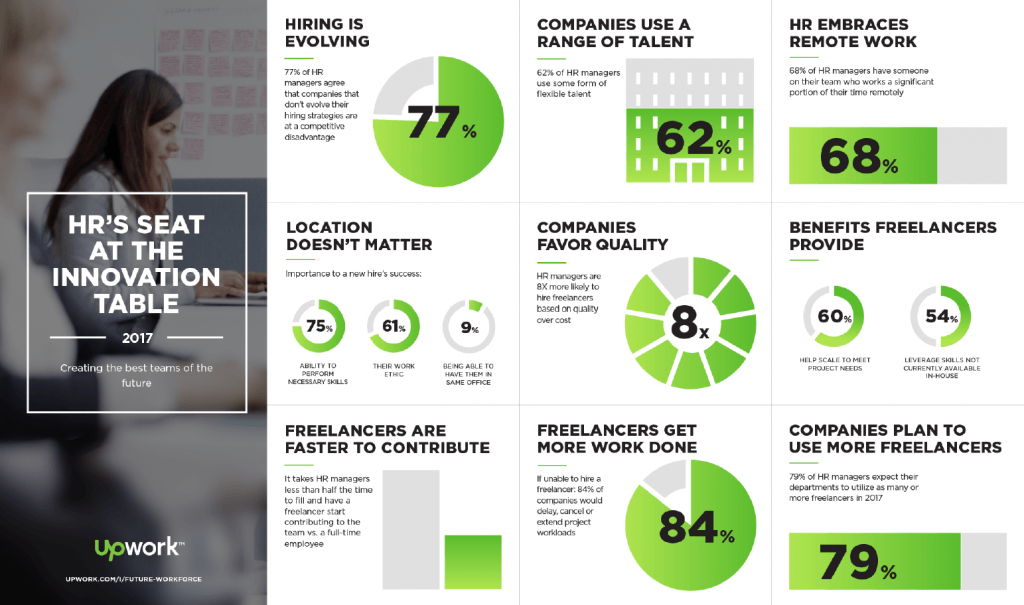
Working On Upwork
Upwork is a freelancing platform offering several gigs (services).
Learn more about this blog series ‘Working In The REAL Gig Economy’ here:
Some of the services offered on Upwork, include article writing, graphics designing, web development, digital marketing, consulting (which is my niche) and a host of others.
Upwork, which was formerly known as Elance-oDesk – a result of a merger between two freelance companies; Elance and oDesk. Is one of the most popular freelancing platforms with an estimated 12 million registered freelancers and about 5 million clients already registered, globally.
How Upwork Works
There are two ways of working with Upwork, either as a client or as a freelancer.
As a client, you start by posting a job/project (after registration). Upwork will then analyse what task you require, and link this to a list of suitable freelancers for the project. Freelancers can also apply directly to you, via a proposal (on Upwork).
The client then goes through the list and compares/matches candidates using their profiles, ratings (client reviews) and proposals. The client then interviews the freelancer (probably through the live chat feature), to see if he/she has the experience to complete the project. The client then agrees to the fee and the project goes ahead.
As a freelancer, you can get hired by clients after signing up and creating a profile, which can showcase your experience and services. You can then wait for client project requests or you can apply for projects by sending small proposals directly to the client. This may enable you to get an “interview” or the project may be assigned immediately.
To make sure that Giggers are fairly billed for their services, Upwork uses milestones, whereby the client releases the money when each milestone (project goal) has been finalised. And for hourly-billed jobs, Upwork offers a time-tracking application, that tracks time and takes screenshots of the computer screen, while you are working.
Remote workers are quite used to showing their work to clients when they reach a milestone or goal. However, it will be interesting to see how “automatic screenshots” of what a contingent worker works on in real-time, fits into the current Data Protection era and today’s legal systems. Perhaps time to focus on changing the foundation of the latter?
How Does Upwork Exist?
Upwork earns from the platform by taking a (large) percentage of the earnings of each freelancer.
They offer on-demand workers several payment methods, including PayPal, Payoneer, Wire Transfer, Skrill, Direct Deposit/ACH or through Local Funds Transfer.
Back then when I first registered for Upwork, the platform received a service fee of 10% for all payments made to the freelancers. But recently, they announced a new “sliding service fee” of 5% to 20% of all freelance payments!
My Personal Experience Working With Upwork
I worked with Elance, a couple of years ago and found it quite easy to use. Unfortunately, at that time, hardly any People focused projects were advertised on the platform.
So, when the two platforms merged to become “Upwork”, I tried again. The platform itself is a great tool, especially to start your remote working or freelancer career.
But I do like to be honest and share what I encountered, whilst working on Upwork.
For one, I had to write a proposal for each client/project, which was very time consuming. Proposal templates help, but you will still need to adapt each template to the project request and client.
Another discouraging side of working with Upwork was the issue of “fake clients”. There were several instances where I wrote a small proposal for a consulting project, to what it seemed a Blue Chip organisation, unfortunately these companies – were fake copycats, only interested in getting as much personal data as possible.
[I did informed the real companies that their name/logo/career pages and contact information was being used on Upwork and their cyber crime teams were on top of it immediately. You learn from everything, right ;)]
On a few other occassions, a fraudster imposing as a client would request my service, only to find out (again) that all they wanted was to get my business/accounting and bank details (phisphing attempts).
The above issues are common on all platforms, but more so on platforms, whereby you have to apply to a client with a short proposal (share more personal information).
Recent Developments
Upwork recently introduced a live chat feature for communication between clients and freelancers, as a way to reduce the time for hiring and interviewing. Which is a good idea, as communicating via comments in real-time is crucial.
Remember that it is not only UpWork that takes a percentage! If you use payment tools, like PayPal, Stripe or Payoneer for receiving client payments. They will also take a small percentage. Then count in the exchange rates and you usually will be left with 2/3 $$ of the overall project fee.
Although I did very well on Upwork with lots of projects and a very good star-rating, I found the proposal writing for new client projects too time consuming (especially for someone with Dyslexia).
I would really suggest you try out working on Upwork though (even if it is only for the experience or as a extra supplement to your fulltime salary).
It is a wonderful way to get into the remote/ freelancer working mode and learn what is changing in the world of work today!
I will continue with my series “My Experiment Of Working In The Real Gig Economy” next week, where I will share information on the new Corporate Contingent job platforms.
© New To HR



